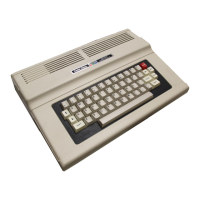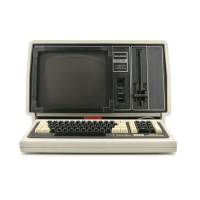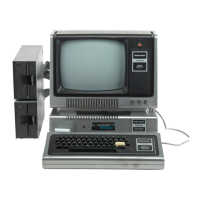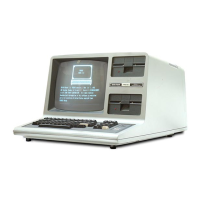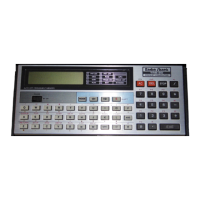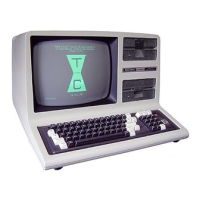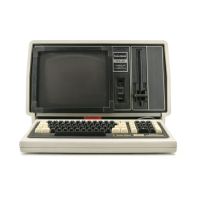RAM
The
next
major section in Figure 1
is
the RAM
(Random Access
Memory).
This
memory
is
where the
CPU
may place data
it
doesn't need
until
later. The RAM
is
also the place where the
programs
are
kept.
If
you tell the
computer
to
count
to
10,000,
then the
CPU
stores
your
instructions in the RAM.
If
you tell the Com-
puter
to
do
it
now, here
is
what
happens:
The
CPU
tells the ROM someone wants in. The
ROM tells the
CPU
to
go
to
the Keyboard and
find
out
who. The
CPU
finds
out,
tells the ROM
that
it's The
boss.
The ROM tells the
CPU
to
find
out
what
he
wants. The
CPU
tells the ROM
that
the
boss
wants us
to
RUN. The ROM tells
the
CPU
to
go
to
RAM and
find
out
what
the
boss
wants done. The
CPU
says
the
boss
wants
to
count
to
10,000.
The ROM tells the
CPU
how
to
do it.
After
it's done, the ROM tells the
CPU
to
find
out
what
to
do
with
it. The
CPU
informs
the ROM
that
the
10,000
has
got
to
go on the
Display and must
be
saved.
The ROM tells the
CPU
how
to
put
it
on the Display and then tells
it
to
store the
10,000
somewhere in
RAM;
but
it
had better remember where
it
is.
The
CPU
tells
the ROM
that
the
job
is
done. The ROM tells
the
CPU
to
monitor
the Keyboard in
case
the
boss
wants something
else.
The
CPU
looks
to
the ROM
for
instructions. The
CPU
then follows the ROM's instructions and
looks
to
the Keyboard, then the RAM. In all
cases,
the
CPU
applies address locations
to
the
ROM,
RAM
and Keyboard. The data lines
are
then checked
for
input
data
that
corresponds
to
these address locations. In
case
of
an
output
from
CPU
to
RAM,
the
CPU
selects the address,
puts data on the data lines and then instructs the
RAM
to
store the data
that
is
on the data lines.
Notice
that
only
the
CPU
communicates
with
all
other
sections.
If
the
CPU
is
told
by
ROM
to
store something
from
ROM
into
RAM, the
CPU
can't
make the RAM receive ROM data direct-
11
Iy. Instead, the
CPU
takes the data
from
ROM
and then
sends
it
to
RAM. The
CPU
must act
as
intermediary between the
two.
The
reason
for
this
is
that
the
CPU
is
the
only
section
that
can
address locations and
pass
data
to
all
other
sections.
Keyboard,
Video
RAM
And
Video
Processing
The Keyboard section
is
not
necessary
as
far
as
the
CPU
is
concerned,
but
it
is
very necessary
for
the operator (that's
you!).
The Keyboard
is
our
method
of
making
known
our
instructions
to
the
CPU.
The opposite
is
true
for
the Video
RAM. In this
case,
the
CPU
wants
to
tell
us
it
needs data
or
it
may
want
to
show
us
the result
of
a complex calculation. So, the request
for
more
information
or
the result
is
stuffed
into
the
Video RAM.
Anything
in Video RAM
is
automatically displayed on the Terminal. The
Video Processing section handles this. Data in
the Video RAM
is
in ASCII. Converting ASCII
into
the alphanumeric symbols we recognize
is
the
job
of
the Video Processor. A
ROM
contains
all
of
the
dot
patterns. The ASC II locates the
character pattern, and the Video Processor
sends
it
out
to
the Terminal.
Video Divider Chain
Composite video going
to
a video terminal
is
extremely complex. Aside
from
the video signal,
there
is
the horizontal and vertical sync. These
signals must
be
very stable and
be
outputted
in the correct sequence. The
CPU
is
busy enough
as
it
is,
so
the Video Divider Chain handles the
TV
work.
It
generates the sync signals and
addresses the Video RAM in a logical order
so
that
the Video Processor
can
handle video data
efficiently.
Notice the
block
under the Video
RAM
labeled
MUX.
This
is
short
for
Multiplexer.
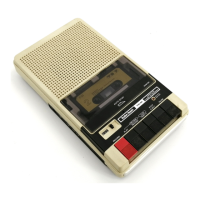
